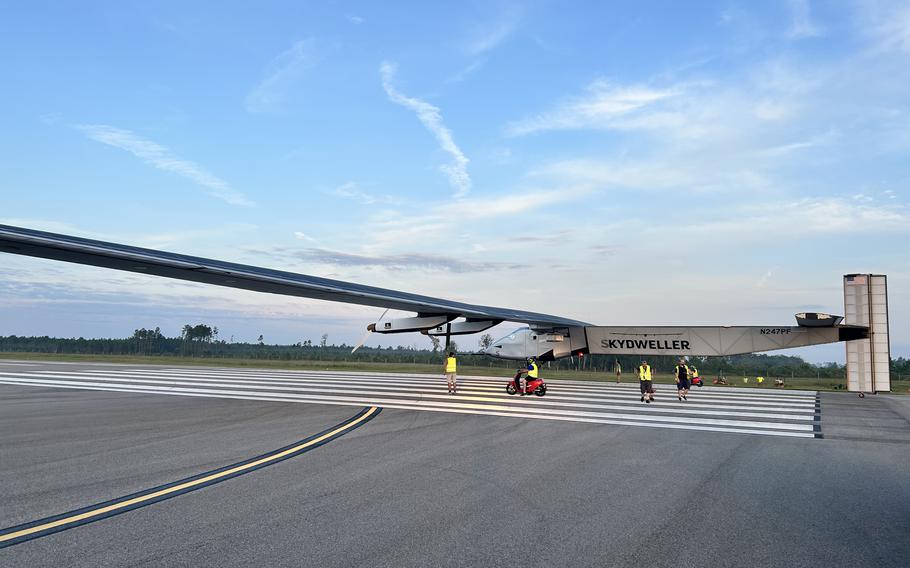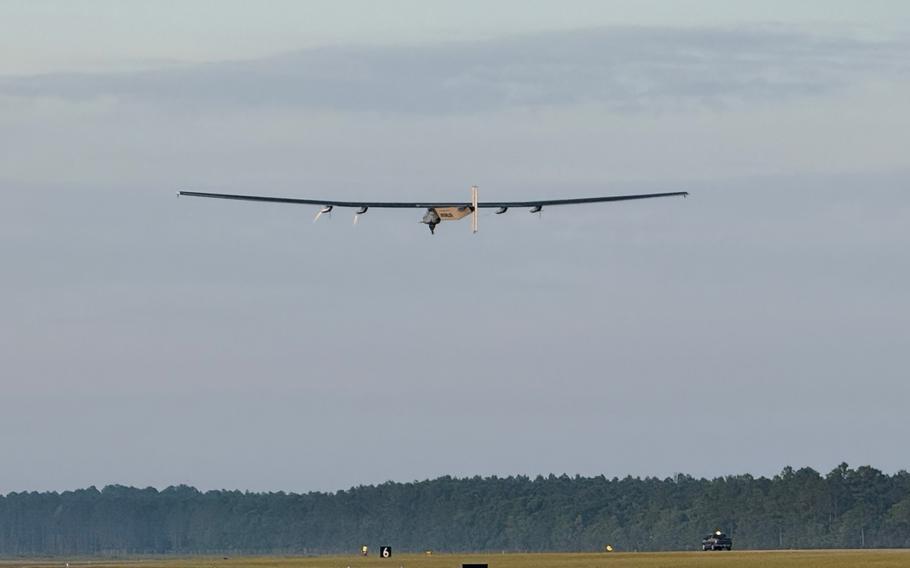
The Navy, in partnership with Skydweller Aero, recently achieved continuous solar-powered unmanned flight during a nonstop three-day test from Stennis, Miss. (Naval Air Warfare Center Aircraft Division)
(Tribune News Service) — From an airstrip just north of Interstate 10 on the Mississippi Gulf Coast, an aviation company recently launched an unmanned plane for a three-day flight, an important milestone on its quest for longer flights using only sunlight as fuel.
Skydweller, the world’s largest solar-powered flying drone — its 236-foot wingspan is bigger than a 747 — recently logged flights of 73 and 74 hours after taking off from its operations base at Stennis International Airport just east of the Louisiana- Mississippi state line, the company says.
The eventual goal? Flights of up to 90 days.
Robert Miller, CEO and co-founder of Skydweller Aero, is confident that goal is near.
“It always takes a little longer than you think, but we’re getting there,” Miller said in a recent interview. “Every 12 months we see a quantum step in where we’re headed.”
The recent test flights mark a big leap from last fall, when the company announced it had made six test flights, including one of 22.5 hours.
Skydweller Aero’s continued success has kept the interest of the U.S. military, which Miller hopes will translate into contracts for additional aircraft that spurs company growth at its hub on the Gulf coast. Skydweller comes to the coast

The Navy, in partnership with Skydweller Aero, recently achieved continuous solar-powered unmanned flight during a nonstop three-day test from Stennis, Miss. (Naval Air Warfare Center Aircraft Division )
The Skydweller project was announced with much fanfare in March 2024, with news releases from the state of Mississippi praising the company and a huge media gathering during which the company showed the aircraft, which resembles a giant glider but weighs less than a Ford F-150 pickup.
Since then, the craft has performed well in a series of tests, the latest of which piled up 222 hours of air time over four separate flights under the watch of the U.S. Naval Air Warfare Center Aircraft Division. That testing included the 73- and 74-hour flights, the company said.
“We really showed the military how it could work,” Miller said. “Our goal is 90 days, and we think we’re on our way to getting there.”
In a news release last month, the Navy praised Skydweller, saying the recent tests marked “a significant advancement” in long-endurance solar flight and the aircraft’s “potential to enhance maritime intelligence, surveillance, and reconnaissance.”
The Navy also said the testing “validated the system’s communication links, autonomous real-time decision making and ability to adapt to turbulent weather.”
Because of Skydweller’s construction and weight, severe weather is a threat. But the recent tests provided some answers, Miller said.
“We don’t fly through thunderstorms, but we fly between them,” he said.
Because of the aircraft is designed to stay aloft for long periods, the military sees it as surveillance tool that could free up more traditional aircraft for other operations, the company says. Cutting edge tech
Skydweller’s huge wingspan is designed to help keep it aloft, while the aircraft’s 17,000 solar cells spend the day collecting sunlight and storing that fuel in the batteries that power the plane at speeds of around 35 mph and altitudes up to 40,000 feet.
Skydweller Aero, a privately-held company headquartered in Oklahoma City, set up shop at Stennis International in 2023, promising a multi-million-dollar investment. The company had $40 million from different investment groups.
Miller said Skydweller is currently building a second solar-powered aircraft, with the parts being made elsewhere and assembled at Stennis. He still envisions a fleet of solar-powered aircraft flying out of Stennis.
“We’ve got to raise some money, but with our success we’re seeing more interest,” Miller said. “People realize this is going to be a game changer.”
Miller said the company is working with the Mississippi Development Authority, the state’s economic development agency, to build a second hangar at Stennis that the company would lease. Miller has said company plans to eventually grow the full-time workforce to 65-75 people in the next couple of years.
“The Gulf Coast is a great home for us,” he said.
© 2025 The Sun Herald (Biloxi, Miss.).
Visit www.sunherald.com.
Distributed by Tribune Content Agency, LLC.